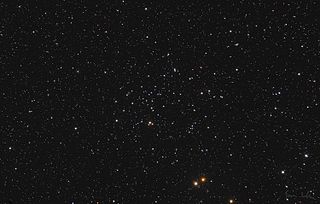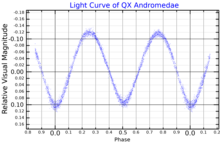
Zeta Andromedae is a star system in the constellation Andromeda. It is approximately 189 light-years from Earth.
56 Andromedae, abbreviated 56 And, is a probable binary star system in the northern constellation of Andromeda. 56 Andromedae is the Flamsteed designation. It has a combined apparent visual magnitude of 5.69, which is just bright enough to be dimly visible to the naked eye under good seeing conditions. The distance to this system can be ascertained from its annual parallax shift, measured at 9.9 mas with the Gaia space observatory, which yields a separation of 330 light years. It is moving further from the Earth with a heliocentric radial velocity of +62 km/s and is traversing the celestial sphere at a relatively high rate of 0.183″ per year. This pair is positioned near the line of sight to the open cluster NGC 752, located 1,490 light-years away.

Phi Cassiopeiae is a star in the constellation Cassiopeia. φ Cassiopeiae is a multiple star with a combined apparent magnitude of +4.95. The two brightest components are A and C, sometimes called φ1 and φ2 Cas. φ Cas A is an F0 bright supergiant of magnitude 4.95 and φ Cas C is a 7.08 magnitude B6 supergiant at 134".

Kappa Crucis is a spectroscopic binary star in the open cluster NGC 4755, which is also known as the Kappa Crucis Cluster or Jewel Box Cluster.

V385 Andromedae is a variable star in the constellation Andromeda, about 360 parsecs (1,200 ly) away. It is a red giant over a hundred times larger than the sun. It has an apparent magnitude around 6.4, just about visible to the naked eye in ideal conditions.
WASP-5 is a magnitude 12 yellow dwarf star located about 910 light-years away in the Phoenix constellation. The star is likely older than Sun, slightly enriched in heavy elements and is rotating rapidly, being spun up by the tides raised by the giant planet on the close orbit.

KQ Puppis is a spectroscopic binary variable star in the constellation Puppis. A red supergiant star and a hot main sequence star orbit each other every 9,742 days. Its apparent magnitude varies between 4.82 and 5.17.
EQ Pegasi is a nearby binary system of two red dwarfs. Both components are flare stars, with spectral types of M4Ve and M6Ve respectively, and a current separation between the components of 5.8 arcseconds. The system is at a distance of 20.4 light-years, and is 950 million years old. The primary star is orbited by one known exoplanet.

V520 Persei is a blue supergiant member of NGC 869, one of the Perseus Double Cluster open clusters. It is an irregular variable star.

BU Crucis is a variable star in the open cluster NGC 4755, which is also known as the Kappa Crucis Cluster or Jewel Box Cluster.
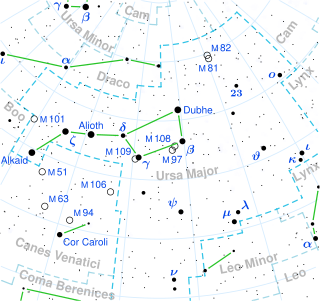
65 Ursae Majoris, abbreviated as 65 UMa, is a star system in the constellation of Ursa Major. With a combined apparent magnitude of about 6.5, it is at the limit of human eyesight and is just barely visible to the naked eye in ideal conditions. It is about 760 light years away from Earth.
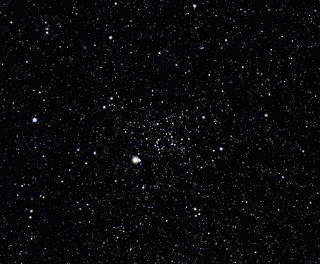
NGC 2539 is an open cluster in the constellation Puppis, located at the north edge of the constellation. It was discovered by William Herschel on January 31, 1785. It is a moderately rich cluster and with little central concentration, with Trumpler class II1m.

AD Andromedae is an eclipsing binary in the constellation Andromeda. Its maximum apparent visual magnitude is 11.2, but it shows a decrease of 0.62 magnitudes during the main eclipse and 0.58 during the secondary one. It is classified as a Beta Lyrae variable star with a period of almost one day.
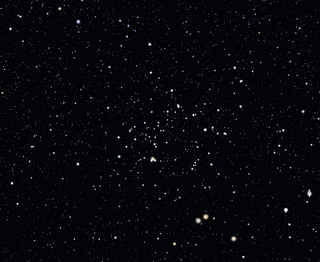
DS Andromedae is an eclipsing binary star in the constellation Andromeda and a member of the open cluster NGC 752. Its maximum apparent visual magnitude is 10.44, but drops down to 10.93 during the main eclipse and to 10.71 during the secondary one.

PX Andromedae is an eclipsing cataclysmic variable star in the constellation Andromeda. It has been classified as a SW Sextantis variable, and its apparent visual magnitude varies between 14.04 and 17.

QR Andromedae is an eclipsing binary star in the constellation Andromeda. Its maximum apparent visual magnitude is 12.16, but its light curve shows clearly eclipsing events where its brightness can drop to a magnitude of 13.07. This leads to its classification as an Algol variable star.

WASP-21 is a G-type star that is reaching the end of its main sequence lifetime approximately 850 light years from Earth in the constellation of Pegasus. The star is relatively metal-poor, having 40% of heavy elements compared to the Sun. Kinematically, WASP-21 belongs to the thick disk of the Milky Way. It has an exoplanet named WASP-21b.
BD-07 436, also known as WASP-77 since 2012, is a binary star system about 344 light-years away. The star's components appears to have a different age, with the secondary older than 9 billion years, while the primary's age is 5 billion years. The BD-07 436 system's concentration of heavy elements is similar to the Sun. Its stars display moderate chromospheric activity, including x-ray flares.
WASP-42 is a K-type main-sequence star. Its surface temperature is 5315±79 K. WASP-42 is similar to the Sun in concentration of heavy elements, with metallicity ([Fe/H]) of 0.05±0.13, and is much older than the Sun at 11.3+1.5
−4.8 billion years. The star does exhibit starspot activity as is typical for its spectral class.
WASP-80 is a K-type main-sequence star about 162 light-years away. The star's age is much younger than the Sun's at 1.352±0.222 billion years. WASP-80 is similar to the Sun in concentration of heavy elements, although this measurement is highly uncertain.
